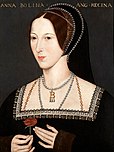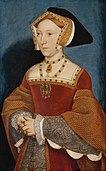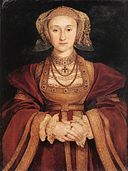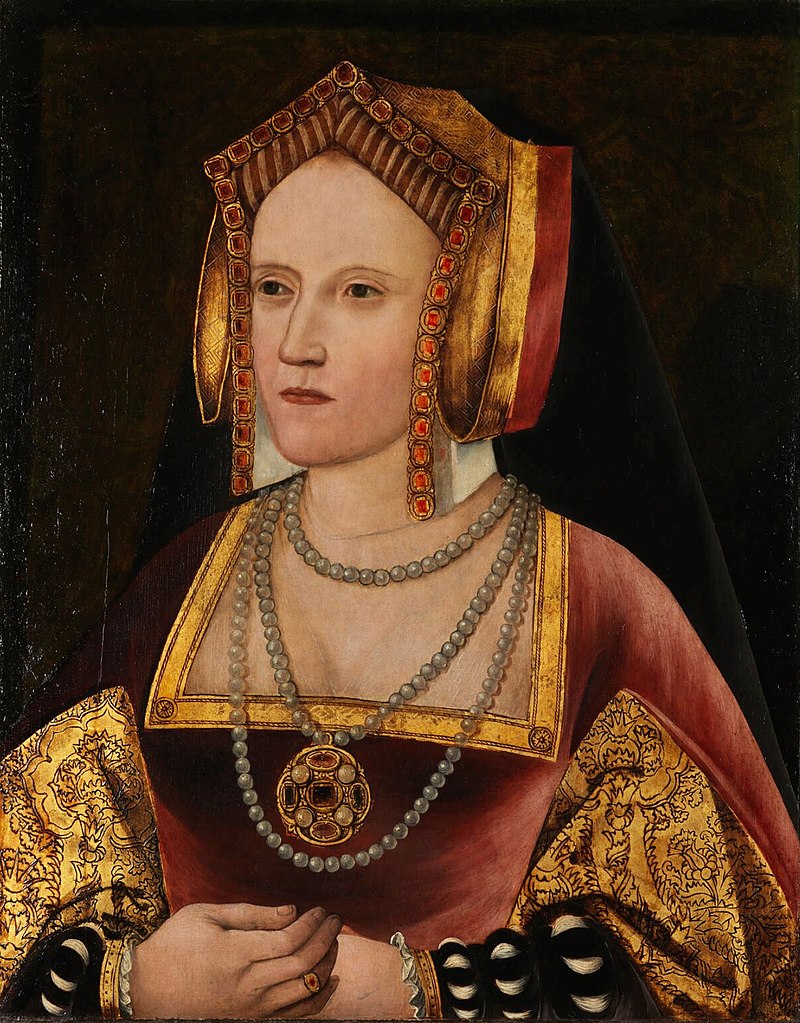Henry VIII feels, in many ways, like the Donald Trump of his time. In his youth, he was a rich, handsome, carefree young man about town who discarded wives as frequently as he changed his doublet.
In old age, he grew moody and cruel, yet still saw himself as a charming, attractive rogue. Everyone around him had to indulge him if they hoped to keep their heads on their shoulders.
He divorced two wives, beheaded two more, and another died giving birth to his only son. Only two wives outlived him. Of his six wives, some shine brighter than others. As an avid reader of historical fiction, I have some pretty strong – and admittedly only partially informed – opinions about that. And so, for entertainment purposes only, I give you Henry VIII’s Wives Ranked.
Worst: Anne Boleyn (Wife #2)
Since I am an Episcopalian, I suppose I should thank her. Henry founded the Church of England just so he could marry her.
The Boleyns were an ambitious family. Anne’s sister, Mary, was Henry’s mistress first – while married to a minor noble at his court. Anne came to court later and caused a sensation with her regal carriage, graceful dancing and fashionable French clothes. Contemporaries also noted her as intelligent and charming.
When Anne came to court in 1526, Henry had been married for seventeen years to Catherine of Aragon, and she had produced only one living child, a daughter. Henry had one acknowledged illegitimate son, and probably several others. But he needed a legitimate son to take the throne after him, and Catherine was getting past childbearing age.
Anne, an acknowledged master of the arts of seduction, saw her opportunity. She charmed and teased Henry sexually, while refusing consummation without a wedding ring. When it became clear that the Catholic Church would refuse to annul Henry’s marriage to Catherine, Anne also became very interested in Protestantism.
Did I mention that she was Catherine’s lady-in-waiting and supposed friend?
Henry and Anne married in a secret ceremony on November 14, 1532, even before the official annulment of Henry’s Marriage to Catherine. Anne soon became pregnant. But, like Mary, she produced only a girl, the future Queen Elizabeth. Later, she had at least one miscarriage.
Anne was vain and a spendthrift, and her marriage to Henry looked like a Jerry Springer episode, a seesaw of bliss alternating with temper tantrums. As she continued to fail at producing an heir, Henry’s eye turned towards her lady-in-waiting, Jane Seymour.
Rumors of Anne’s infidelity to Henry have followed her through the centuries. They may be untrue. Henry and his advisors certainly had an incentive to cook up an excuse to behead her.
But we know for sure that she broke up Henry’s marriage. And, I don’t care what church you belong to or what era you come from, it’s just wrong to steal another woman’s husband. When Henry had her beheaded so that he could marry Jane Seymour, Anne found out that “what goes around comes around.”
Second Worst: Catherine Howard (Wife #5)
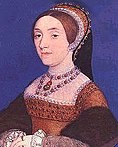
Pretty little Kitty. Someone recently described her as “poor ditzy Kitty,” and that’s about right.
Like both Anne Boleyn and Jane Seymour, she apprenticed for the job of wife to Henry VIII by serving as lady-in-waiting to his current wife (Anne of Cleves at that time). She was also a cousin to both Anne Boleyn and Jane Seymour.
Contemporaries described Kitty as pretty, frivolous and giddy. She loved both dancing and flirting, like any pretty teenage girl. She also showed the poor judgment often associated with pretty teenage girls.
In her mid-teens, she had an affair with a much older man, which may have been abusive. A few years later, she had another affair, with Francis Dereham, and may have exchanged betrothal vows with him.
The aging Henry became besotted with Kitty almost as soon as he laid eyes on her. As soon as he could dump Anne of Cleves, the two married. And almost as soon as they were married, Kitty apparently started a love affair with one of Henry’s courtiers, Thomas Culpepper.
By this time, Henry was fifty years old. First, he had no business marrying Kitty, who was about eighteen. Second, there’s nothing more fragile than the ego of an aging Lothario. In rage, Henry had his marriage to Kitty annulled on the basis that she had been betrothed to Dereham. He also had both Dereham and Culpepper executed, on the well-known principle that One Does Not Cuckold an Aging and Egotistical Autocrat.
Finally, on February 10, 1542, poor, ditzy Kitty also lost her head on basically the same principle.
History hasn’t treated Kitty kindly. One historian described her as a “juvenile delinquent,” another as “a stupid and oversexed adolescent.” The poor little thing probably was brainless and selfish, but she was also a child, so I feel a little sorry for her.
Reluctant Homewrecker: Jane Seymour (Wife #3)
Like both Anne and Kitty, Jane caught Henry’s eye when she served as lady-in-waiting to his current wife. But, unlike them, Jane was a reluctant homewrecker. Jane apparently didn’t make a play for Henry. Even as he began to pursue her, she maintained her chastity until marriage. But her family had great interest in the political advantages of her relationship with Henry, and did what they could behind the scenes to get Boleyn out of the way.
Contemporaries described Jane as meek and gentle, and very skilled at needlework. She treated her step-daughters, Mary and Elizabeth, with kindness and played an especially significant role in reconciling Henry with young Mary.
Jane came from a big family, so Henry had reason to believe she would be fertile. And, on October 12, 1537 – after a labor lasting two days and three nights – Jane gave birth to a baby boy, the future King Edward VI. Twelve days later, she died.
Having given him his only legitimate son, Jane ranked as Henry’s favorite wife. When Henry died, he requested to be buried next to her.
Kept Her Head: Anne of Cleves (Wife #4)
Everyone knows that a king needs not just an heir, but also a spare. Although Henry apparently grieved Jane Seymour, negotiations for his next wife began almost immediately. This time, Henry allowed himself to be persuaded by political considerations rather than by his penis. His advisors wanted an alliance with William of Cleves, a Protestant leader in western Germany, and William had an eligible sister in Anne.
Like Jane Seymour, Anne was described as gentle and skilled at needlework. She could speak a little English, but could read and write only in German.
Henry and Anne had only seen portraits of each other before she arrived in England in December 1539. Their first meeting did not go well.
The aging Henry, still seeing himself as a charming young rogue, had come up with a “meet cute” scheme. He would, in disguise, approach his bride in her chamber with an embrace, a kiss and a “token.” Naturally startled, Anne did not react well to Henry’s little surprise. And, like the petulant overgrown boy that he was, Henry felt insulted.
The two married on January 6, 1540, but never consummated their union. Henry claimed that Anne wasn’t as pretty as her portrait made her look, and it seems that she was also naïve about sexual relations. Possibly, Henry suffered from intermittent impotence by this time.
Anne agreed to an annulment in July 1540, on the grounds of non-consummation. And she came out of the marriage in much better shape than any of her predecessors. Mainly, she still had her head. Henry allowed her to keep her dower lands, and gave her a generous settlement, including at least three homes. She remained friendly with Henry and with her two step-daughters, Mary and Elizabeth. A contemporary chronicler described her as “a ladie of right commendable regards, courteous, gentle, a good housekeeper and verie bountifull to her servants.”
Second Best: Catherine of Aragon (Wife #1)
Catherine’s parents were King Ferdinand and Queen Isabella of Castile, the same Ferdinand and Isabella who financed Columbus’s 1492 journey to the Americas. As a descendant of both of the first two wives of John of Gaunt, she herself had a distant claim to the English throne. Thus, her marriage into the upstart Tudor family strengthened their legitimacy.
She first married Henry’s older brother Arthur, but he died shortly after their wedding. Henry’s desire to marry his brother’s widow was complicated by a Church ban on such a marriage.
The marriage went forward in 1509 after Catherine swore -probably falsely – that her marriage to Arthur had never been consummated. Henry was only eighteen. Catherine was twenty-four.
By most accounts, Henry adored Catherine, and trusted her completely. He appointed her regent when he went on military campaigns. In one of the wars with Scotland, she rode north in armor – and several months pregnant! – to encourage troops in the Midlands.
One thing that the redoubtable Catherine could not do: provide a male heir. She had at least three stillbirths between 1510 and 1514. One son, Henry, may have lived for a few hours. She produced a daughter, the future Queen Mary, in 1516. Another pregnancy ended in a stillbirth in 1518. Catherine was only 33 at the time, but she had no further known pregnancies. By 1525, Henry’s eye had turned to Anne Boleyn.
I like Catherine because she fought for her marriage and for what she believed was right. “God never called me to a nunnery,” she said, “I am the King’s true and legitimate wife.” After Henry set her aside, he held her daughter basically hostage. Catherine and Mary longed for each other’s company, but Henry had banished them both from court to separate locations. He offered to allow them to reunite only if they would acknowledge Anne Boleyn as the true queen of England. They both refused.
Catherine’s final letter to Henry, as she knew she was dying in late 1535, is poignant:
” My most dear lord, king and husband,
The hour of my death now drawing on, the tender love I owe you forceth me, my case being such, to commend myself to you, and to put you in remembrance with a few words of the health and safeguard of your soul which you ought to prefer before all worldly matters, and before the care and pampering of your body, for the which you have cast me into many calamities and yourself into many troubles.
For my part, I pardon you everything, and I wish to devoutly pray God that He will pardon you also. For the rest, I commend unto you our daughter Mary, beseeching you to be a good father unto her, as I have heretofore desired. I entreat you also, on behalf of my maids, to give them marriage portions, which is not much, they being but three. For all my other servants I solicit the wages due them, and a year more, lest they be unprovided for. Lastly, I make this vow, that mine eyes desire you above all things.
Katharine the Quene.”
Best and Last: Katherine Parr
Henry loved his Katherines; Parr was the third. And, in my opinion, she was Henry’s best wife.
By the time Katherine married Henry, he was well into his fifties. He was fat, suffered from both diabetes and gout, and had stinking sores on his leg from an old wound. He was cranky, mercurial, and hard to live with. Katherine didn’t want to marry him. She’d had two husbands already, and was probably already in love with her fourth husband, Thomas Seymour. But, if Henry wanted to marry you, you married him or you died.
Katherine spoke French, Latin, Italian and Spanish, in addition to English. She was a committed Protestant at a time when the country was still bitterly divided and Henry himself wavered back and forth. She wrote three books. Not some trashy memoir like you’d probably see today, but books of prayers and meditations. Her “Prayer for the King” is still in the English Book of Common Prayer. She may also have translated the Gospels into English.
Like Jane Seymour and Anne of Cleves, Katherine maintained loving relations with her step-daughters, the future Queens Mary and Elizabeth.
For her erudition, her kindness to her step-children and her endurance of Henry at his absolute worst, Katherine stands out to me as Henry’s most admirable wife.
Katherine Parr and Anne of Cleves were the only two wives to outlive Henry. Henry died on January 28, 1547, of complications of gout. Katherine died in childbirth on September 5, 1548. Anne died on July 16, 1557, probably of cancer.
Sources
Most of the historical facts in this post came from Wikipedia
https://en.wikipedia.org/wiki/Wives_of_Henry_VIII
But the stories of these fascinating queens are best brought to life in fiction. I especially enjoy Philippa Gregory’s series of books on the Tudor queens:
The Other Boleyn Girl
The Boleyn Inheritance
The Constant Princess
The Taming of the Queen


